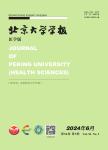中国汉族人群腓骨肌萎缩症Cx32基因突变分析(英文)
Mutation screening of Cx32 in Han Chinese patients with Charcot-Marie-Tooth disease作者机构:中南大学湘雅医院神经内科长沙410008 中南大学湘雅三医院神经内科 浙江医科大学附属一医院神经内科 中南大学湘雅医院医学遗传学国家重点实验室
出 版 物:《北京大学学报(医学版)》 (Journal of Peking University:Health Sciences)
年 卷 期:2005年第37卷第1期
页 面:68-71页
核心收录:
学科分类:1002[医学-临床医学] 100204[医学-神经病学] 10[医学]
基 金:国家高技术研究发展计划专项经费 (2 0 0 1AA2 2 70 1 1 ,2 0 0 4AA2 2 70 4 0 ) 国家自然科学基金 (3990 0 0 4 7,30 30 0 2 0 0 )资助~~
主 题:腓骨肌萎缩症 X染色体 连接蛋白类 遗传性疾病 突变
摘 要:Objective: To investigate the Cx32 mutation features and the clinical manifestations of Chinese patients with Charcot-Marie-Tooth disease(CMT). Methods: Twenty-four of 65 unrelated CMT patients were selected for Cx32 mutation screening after the exclusion of the CMT1A 1.5 Mb duplication and male-to-male transmission. The motor and sensory nerve conduction studies were performed in all probands and most of their affected family members to establish the clinical CMT1 ,CMT2 or CMT intermediate diagnosis. The presence of mutations in the coding region of Cx32 was detected by single-strand conformation polymorphism analysis combined with direct sequencing. Results: We found 7 different point mutations in the coding region of Cx32 in a total of 7 families. All the patients were mildly to moderately affected with a clinical CMT1 or CMT intermediate diagnosis. The mutation Arg15Gln was inherited with X-linked recessive trait in family 1 involved in our study. The Arg75Trp mutation was detected in a family with X-linked dominant CMT and autosomal recessive nonsydromic hearing loss. The clinical phenotype of the Thr188Ala mutation was firstly reported. Conclusion: Seven different Cx32 point mutations were detected and the percentage of Chinese CMT families with Cx32 mutation is about 10% in our study. The inheritance model of CMT secondary to Cx32 mutation could be X-linked dominant, X-linked recessive or sporadic. Male patients are usually more severely affected than females with slower nerve conduction velocities. Cx32 mutation screening should be firstly performed in those CMT families without male-to-male transmission and CMT1A duplication.



